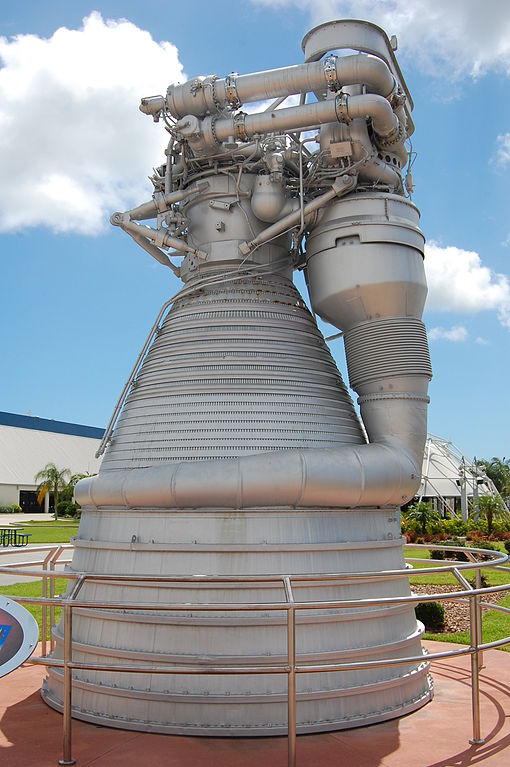Designation: F1B
F1 engine displayed at KSC

Pratt & Whitney Rocketdyne is working toward a full-scale turbomachinery test next year of the F-1B kerosene fueled rocket engine it is developing with Dynetics as a potential power plant for the advanced side-mounted boosters NASA will need to meet the 130-metric-ton congressional requirement for its planned Space Launch System.
The company displayed a vintage F-1 gas generator and turbomachinery unit at the National Space Symposium here. The flight hardware, left over from the Saturn V program, dwarfed other full-scale rocket engines the company had on display in its exhibition-hall booth. The company has two more F-1A engines that it is using for its NASA work.
“We’ve torn them down and inspected them to see how they look,†said Main combustion chamber development lead Tom Martin. “We’re refurbishing those. We’re taking some of the components and using modern processes to replicate that hardware.â€
PWR is using the vintage gas-generator cycle to get the SLS off the pad, relying on its 1.8 million-lb. thrust capability to provide the needed boost even without the efficiency of a staged-combustion engine that is also in the running under NASA’s advanced booster program.
The proposed Aerojet AJ-1E6 is an oxygen-rich staged, two-combustion chamber configuration similar to the Atlas V’s RD-180, but is less powerful than the F-1B. While two F-1Bs would be used on each of the two SLS boosters, a total of four AJ-1E6s would be required for the same power.
Pratt & Whitney Rocketdyne and Dynetics’ improved F-1 version incorporates a simplified F-1A turbopump and exhaust duct, as well as changes to the nozzle design and combustion chamber. Changes to the latter component include the adoption of a new hot-isostatic press-(HIP) bond assembly process for the main combustion chamber, as well as a new channel-wall nozzle made using simplified, less expensive manufacturing processes. “The HIP-bonded main combustion chamber gives us more thermal margin,†says Ron Ramos, PWR’s vice president for Exploration and Missile Defense.
PWR is also using additive manufacturing selective laser melting techniques to develop an optimized injector for the gas generator. “Designing and making the part is in the scope of the program, but is not part of the scope of the hot fire element,†says Ramos who adds the company may attempt to include the injector when this takes place.
PWR took over testing of a heritage F-1A gas generator earlier this year from NASA at Marshall Space Flight Center, and has subsequently refurbished the engine components using the company-developed improved manufacturing techniques. “We will take the gas generator that we and Marshall tested, and do a power pack test at [NASA] Stennis. It will be the largest flow test,†said Martin. The exercise will wrap up the 30-month program and is scheduled for “late 2014,†he said.
With the proposed $550 million Aerojet purchase of PWR still awaiting Federal Trade Commission approval, PWR President Jim Maser says “until that decision is made we’re pursuing a strategy independent of that decision. We believe we have the winning strategy.â€
>
>
The company displayed a vintage F-1 gas generator and turbomachinery unit at the National Space Symposium here. The flight hardware, left over from the Saturn V program, dwarfed other full-scale rocket engines the company had on display in its exhibition-hall booth. The company has two more F-1A engines that it is using for its NASA work.
“We’ve torn them down and inspected them to see how they look,†said Main combustion chamber development lead Tom Martin. “We’re refurbishing those. We’re taking some of the components and using modern processes to replicate that hardware.â€
PWR is using the vintage gas-generator cycle to get the SLS off the pad, relying on its 1.8 million-lb. thrust capability to provide the needed boost even without the efficiency of a staged-combustion engine that is also in the running under NASA’s advanced booster program.
The proposed Aerojet AJ-1E6 is an oxygen-rich staged, two-combustion chamber configuration similar to the Atlas V’s RD-180, but is less powerful than the F-1B. While two F-1Bs would be used on each of the two SLS boosters, a total of four AJ-1E6s would be required for the same power.
Pratt & Whitney Rocketdyne and Dynetics’ improved F-1 version incorporates a simplified F-1A turbopump and exhaust duct, as well as changes to the nozzle design and combustion chamber. Changes to the latter component include the adoption of a new hot-isostatic press-(HIP) bond assembly process for the main combustion chamber, as well as a new channel-wall nozzle made using simplified, less expensive manufacturing processes. “The HIP-bonded main combustion chamber gives us more thermal margin,†says Ron Ramos, PWR’s vice president for Exploration and Missile Defense.
PWR is also using additive manufacturing selective laser melting techniques to develop an optimized injector for the gas generator. “Designing and making the part is in the scope of the program, but is not part of the scope of the hot fire element,†says Ramos who adds the company may attempt to include the injector when this takes place.
PWR took over testing of a heritage F-1A gas generator earlier this year from NASA at Marshall Space Flight Center, and has subsequently refurbished the engine components using the company-developed improved manufacturing techniques. “We will take the gas generator that we and Marshall tested, and do a power pack test at [NASA] Stennis. It will be the largest flow test,†said Martin. The exercise will wrap up the 30-month program and is scheduled for “late 2014,†he said.
With the proposed $550 million Aerojet purchase of PWR still awaiting Federal Trade Commission approval, PWR President Jim Maser says “until that decision is made we’re pursuing a strategy independent of that decision. We believe we have the winning strategy.â€
>
>

